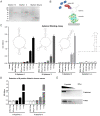A DNA Aptamer Based Method for Detection of SARS-CoV-2 Nucleocapsid Protein
- PMID: 32451881
- PMCID: PMC7246297
- DOI: 10.1007/s12250-020-00236-z
A DNA Aptamer Based Method for Detection of SARS-CoV-2 Nucleocapsid Protein
Conflict of interest statement
The authors declare that they have no conflict of interest.
Figures

Comment on
-
Application of Aptamers in Virus Detection and Antiviral Therapy.Front Microbiol. 2019 Jul 3;10:1462. doi: 10.3389/fmicb.2019.01462. eCollection 2019. Front Microbiol. 2019. PMID: 31333603 Free PMC article. Review.
Similar articles
-
Quantitative and sensitive detection of SARS coronavirus nucleocapsid protein using quantum dots-conjugated RNA aptamer on chip.J Chem Technol Biotechnol. 2011 Dec;86(12):1475-1479. doi: 10.1002/jctb.2721. Epub 2011 Oct 3. J Chem Technol Biotechnol. 2011. PMID: 32336860 Free PMC article.
-
Relative rates of non-pneumonic SARS coronavirus infection and SARS coronavirus pneumonia.Lancet. 2004 Mar 13;363(9412):841-5. doi: 10.1016/S0140-6736(04)15729-2. Lancet. 2004. PMID: 15031027 Free PMC article.
-
Novel rapid immunochromatographic test based on an enzyme immunoassay for detecting nucleocapsid antigen in SARS-associated coronavirus.J Clin Lab Anal. 2005;19(4):150-9. doi: 10.1002/jcla.20070. J Clin Lab Anal. 2005. PMID: 16025480 Free PMC article.
-
The nucleocapsid protein of SARS coronavirus has a high binding affinity to the human cellular heterogeneous nuclear ribonucleoprotein A1.FEBS Lett. 2005 May 9;579(12):2623-8. doi: 10.1016/j.febslet.2005.03.080. Epub 2005 Apr 9. FEBS Lett. 2005. PMID: 15862300 Free PMC article.
Cited by
-
Nucleocapsid protein binding DNA aptamers for detection of SARS-COV-2.Curr Res Biotechnol. 2023;5:100132. doi: 10.1016/j.crbiot.2023.100132. Epub 2023 May 27. Curr Res Biotechnol. 2023. PMID: 37275459 Free PMC article.
-
A Defective Viral Particle Approach to COVID-19.Cells. 2022 Jan 17;11(2):302. doi: 10.3390/cells11020302. Cells. 2022. PMID: 35053418 Free PMC article. Review.
-
Applications in Which Aptamers Are Needed or Wanted in Diagnostics and Therapeutics.Pharmaceuticals (Basel). 2022 Jun 1;15(6):693. doi: 10.3390/ph15060693. Pharmaceuticals (Basel). 2022. PMID: 35745612 Free PMC article. Review.
-
Development of Novel ssDNA Aptamers for Detection of Receptor-Binding Domain of SARS-COV‑2.ACS Omega. 2025 Jun 3;10(23):23981-23992. doi: 10.1021/acsomega.4c03580. eCollection 2025 Jun 17. ACS Omega. 2025. PMID: 40547623 Free PMC article.
-
Aptamers, the bivalent agents as probes and therapies for coronavirus infections: A systematic review.Mol Cell Probes. 2020 Oct;53:101636. doi: 10.1016/j.mcp.2020.101636. Epub 2020 Jul 4. Mol Cell Probes. 2020. PMID: 32634550 Free PMC article.
References
-
- Chan JF, Yuan S, Kok KH, To KK, Chu H, Yang J, Xing F, Liu J, Yip CC, Poon RW, Tsoi HW, Lo SK, Chan KH, Poon VK, Chan WM, Ip JD, Cai JP, Cheng VC, Chen H, Hui CK, Yuen KY. A familial cluster of pneumonia associated with the 2019 novel coronavirus indicating person-to-person transmission: a study of a family cluster. Lancet. 2020;395:514–523. doi: 10.1016/S0140-6736(20)30154-9. - DOI - PMC - PubMed
Publication types
LinkOut - more resources
Full Text Sources
Other Literature Sources
Medical
Miscellaneous

